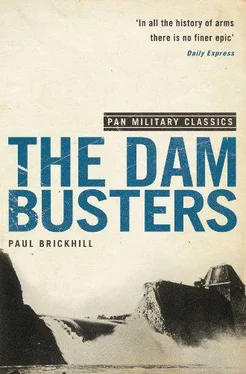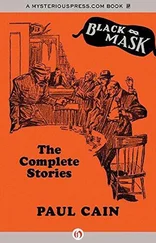“Such earth movements,” said a learned paper, “are capable of doing much damage at great distances.”
It looked as though Wallis had found his answer. Or part of it.
HE worked out theoretical effects, more pages of figures, and decided there was a chance that a 10-ton bomb exploding deep in water by a dam wall would punch out a hole a hundred feet across.
Supposing the bomb did not go as deeply into the earth as the figures predicted? Wallis worked out the effects of a 10-tonner exploding about 40 feet deep. In theory it would throw out the staggering amount of 12,000 tons of earth, leaving a crater 70 feet deep, with lips 250 feet across. He worked out the circumference of the crater and from that the maximum number of men and machines that could gather round the edges. Working day and night they could not fill it in under fourteen days! Supposing one such bomb was dropped accurately in a marshalling yard! Or on a vital railway or canal or road where ground contours prohibited a detour!
Wallis did not get too excited. No bomber in the world would carry a 10-ton bomb. Or for that matter even a 5-ton bomb far enough to get it to a target.
Back to pencil and paper. He knew the limitations of aircraft design in 1940 and in a couple of weeks he knew it was possible to build a 50-ton bomber to carry a 10-ton bomb 4,000 miles at 320 m.p.h. and a height of 45,000 feet. He drew up rough specifications and christened it the “Victory Bomber.”
And the aiming of bombs—notoriously hit and miss, mostly miss. Wallis found that increasing height did not greatly increase the problems and estimated that new bomb sights being developed and special training could put the bombs near enough to a target to destroy it.
That was the beauty of this 10-ton bomb. It should not have to be a direct hit! The earthquake shock would be so great that a near miss should shake a target to destruction. And another thing—a big bomb exploding 130 feet deep would not crater the surface but cause a huge subterranean cavern. Put such a bomb alongside a bridge or viaduct, and if the shock wave did not shake it to pieces the cavern underneath would knock its support away. An opening trapdoor—a hangman’s drop! The bridge would collapse into it.
There was one other possibility in it—perhaps the greatest of all. A few such bombs, accurately aimed, might shatter the roots of a nation’s war effort. That could mean the end of the dreadful “Guernica” carpet bombing, which saturated an area with bombs so limited in effect that the area had to be saturated to make their use militarily worth while. Wiping out cities and civilians at the same time!
Wallis spent weeks setting it all out on paper and took it to people he knew in the R.A.F. and the Ministry of Aircraft Production. It was Dunkirk time. A potent new weapon had never been better timed.
Wallis’s paper on the “earthquake bomb” roused three main emotions in officials: (1) Lukewarm interest. (2) Incomprehension. (3) Tactful derision.
One man understood and did what he could: Arthur Tedder, a quiet, intensely likeable man smoking a pipe, chained to a desk in Whitehall. But he was only an air vice-marshal then and did not have the influence he acquired later. He brought the bomb and Victory Bomber to the attention of several people in high places but the only result seemed to be a ubiquitous manifestation of courteous but implacable inactivity. Every machine in the country was working overtime on other vital things and the ambitious and excellent four-engined bomber project was just getting under way. It was a fair assumption that it might be disastrous to dislocate that in favour of the Victory Bomber, which would inevitably take much longer to develop. That automatically prejudiced the shock-wave bomb, because there was therefore no aircraft in sight which could drop it from Wallis’s prescribed height of 40,000 feet. The new bombers would probably not be able to lift it or, if they could, to carry it far enough to drop it from higher than 20,000 feet, which was not likely to be enough.
And then on July 19, out of the blue, Wallis got an urgent summons to see Lord Beaverbrook, the bright-eyed firecracker who was Minister for Aircraft Production. With “The Beaver” interested anything could happen, and probably at speed. He caught the first: train to London, cooled his heels a few minutes in an ante-room and then the big door opened and a young man said:
“Lord Beaverbrook will see you now, sir.”
Wallis jumped up, cuddling his calculations under his arm, and crossed the threshold, nervous with anticipation; and there was the little man with the wide, mobile mouth, sitting slightly hunched in his chair. It was the speed with which things happened that shook Wallis as much as the things themselves. No gracious, measured preliminaries. He was still in the middle of the floor, walking, when the little man barked:
“What’s this about a ten-ton bomb?”
Wallis told him as concisely as he could; difficult for a scientist, who always feels compelled to go into technicalities, but he kept it short and lucid and Beaverbrook was interested.
“You know how short we are of stuff,” he said. “This thing’s only a theory. We’d have to stop work on other vital things to make it and then it might be a flop.”
“It won’t be that,” Wallis said stubbornly.
“We’d still have to stop work on other things.”
“It will be worth it.”
“Take too long, wouldn’t it?” said “The Beaver.” “A ten-ton bomb and a bomber twice the size of anything else sounds like something in the distant future.”
“We can do it in stages, sir,” Wallis said. “I’ve got drawings for two-ton and six-ton bombs on the same principle. My Wellingtons can carry the two-tonner all right. The new four-engined ones can carry the six-tonner. They’ll be operating in a year.”
“Well, I’ll see my experts about it,” Beaverbrook said. “If it’s going to mean diverting too much effort I don’t like your chances.”
Little seemed to happen for a while but behind the scenes things were moving in a ponderous government way. Little snippets filtered through to Wallis, particularly from that astute ally, Arthur Tedder. Nothing much; just that So-and-so had consented to look into the idea and that So-and-so had expressed mild interest. Wallis thought the prospects were still favourable. Sir Charles Craven, managing director of Vickers, was sympathetic and felt confident enough on November I to write to Beaverbrook suggesting he give permission to go ahead on both 10-ton bomb and Victory Bomber.
Then Tedder was posted to take over the R.A.F. in the Middle East and Wallis had lost his keenest supporter in the sacred and essential precincts of Whitehall. It was soon after that Craven sent for him.
“I’m afraid I haven’t very encouraging news for you,” Craven said as kindly as he could. “Air Council seem too wary of big bombs. They still believe stick bombing is necessary.”
“But can’t they see what a really big bomb would do?” Wallis said pleadingly.
“Apparently not. They say that from experience they would rather drop four 250-pound bombs than a thousand-pounder. Much less a 22,000-pounder.”
“Could they understand my calculations, sir?”
Craven did not comment on their understanding. He said diplomatically that he doubted whether the members would have the time to go individually through all the calculations. Which was probably true. And then gently: “They say that anyone who thinks of ten-ton bombs is mad.”
Wallis went back to Weybridge in anger, but in the morning the anger had mostly gone and in its place was outraged stubbornness. He started writing a treatise on his 10-ton bomb and called it “A note on a method of attacking the Axis Powers,” the kind of obscure title so favoured by scientists; the word “note” being particularly misleading, as such things are often as long as a book.
Читать дальше












